Last updated on
Explore the importance and considerations of having a vent hood in your outdoor kitchen for an optimal cooking experience.
Outdoor kitchens have become increasingly popular in recent years, as homeowners seek to extend their living spaces and create a seamless connection between the indoors and outdoors. From grilling stations to pizza ovens, outdoor kitchens offer a whole new level of culinary enjoyment.
But when it comes to designing an outdoor kitchen, one question that often arises is whether or not you need a vent hood. In this article, we’ll explore the importance of vent hoods for outdoor kitchens and why they might be a worthwhile addition to your setup.
So let’s dive in and find out if you really need a vent hood for your outdoor cooking space!
What's Inside
Understanding Outdoor Kitchens
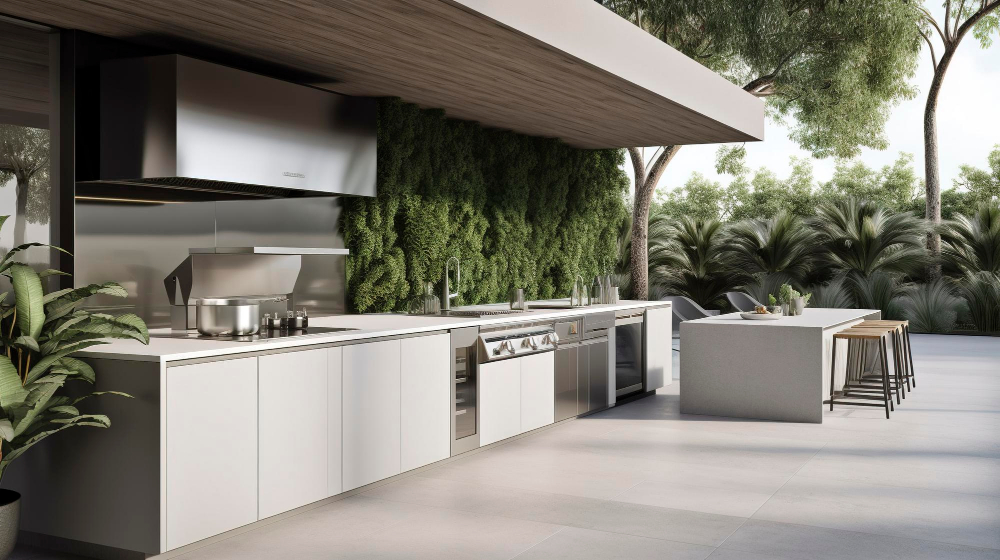
Outdoor kitchens have revolutionized the way we entertain and enjoy our outdoor spaces. Gone are the days of simply grilling on a small portable barbecue; now, homeowners are creating fully functional cooking areas that rival their indoor counterparts.
But what exactly is an outdoor kitchen?
An outdoor kitchen is essentially an extension of your home’s interior living space, designed specifically for cooking and entertaining outdoors. It typically includes appliances such as grills, cooktops, pizza ovens, refrigerators, sinks, and even dishwashers – all strategically placed within a designated area in your backyard or patio.
The concept behind an outdoor kitchen goes beyond just having a place to prepare meals outside; it’s about creating a seamless transition between indoor and outdoor living. Imagine hosting friends or family for a summer gathering where you can effortlessly move from prepping food indoors to cooking it outdoors while still being part of the conversation.
Outdoor kitchens offer numerous benefits beyond convenience alone. They provide opportunities for socializing with guests while preparing meals together or enjoying drinks by the grill.
They allow you to expand your culinary repertoire by experimenting with different flavors and techniques that are best suited for open-air cooking.
What Is a Vent Hood?
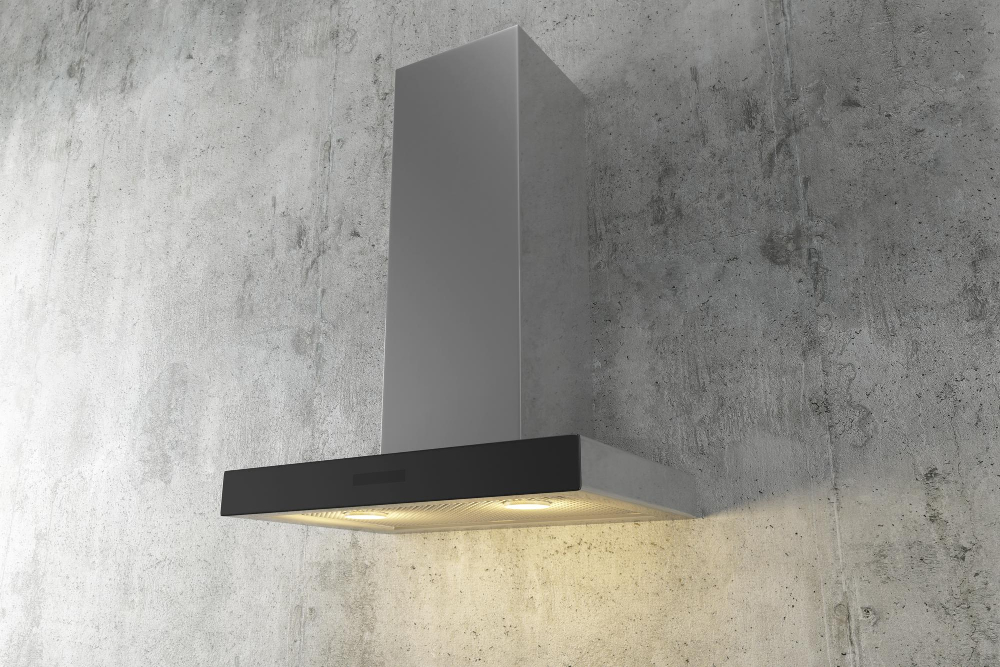
Its primary function is to remove smoke, odors, grease particles, and other airborne pollutants that are generated during cooking. In indoor kitchens, vent hoods are commonly installed above stovetops or ranges to effectively capture and expel these byproducts outside the home.
But what about outdoor kitchens? Well, the purpose of a vent hood remains the same – to ensure proper ventilation and maintain air quality while you cook. However, there are some key differences when it comes to choosing a vent hood for your outdoor cooking space.
Outdoor kitchen vent hoods are specifically designed with weather-resistant materials that can withstand exposure to elements like rain and UV rays. They come in various styles such as wall-mounted hoods or island hoods depending on your setup.
The main goal of having a vent hood in your outdoor kitchen is twofold: first and foremost is safety – it helps prevent excessive heat buildup which could potentially damage surrounding structures; secondly – it ensures comfort by removing smoke from grilling activities so you can enjoy your meals without being overwhelmed by fumes.
Understanding the Importance of Vent Hoods for Outdoor Kitchens
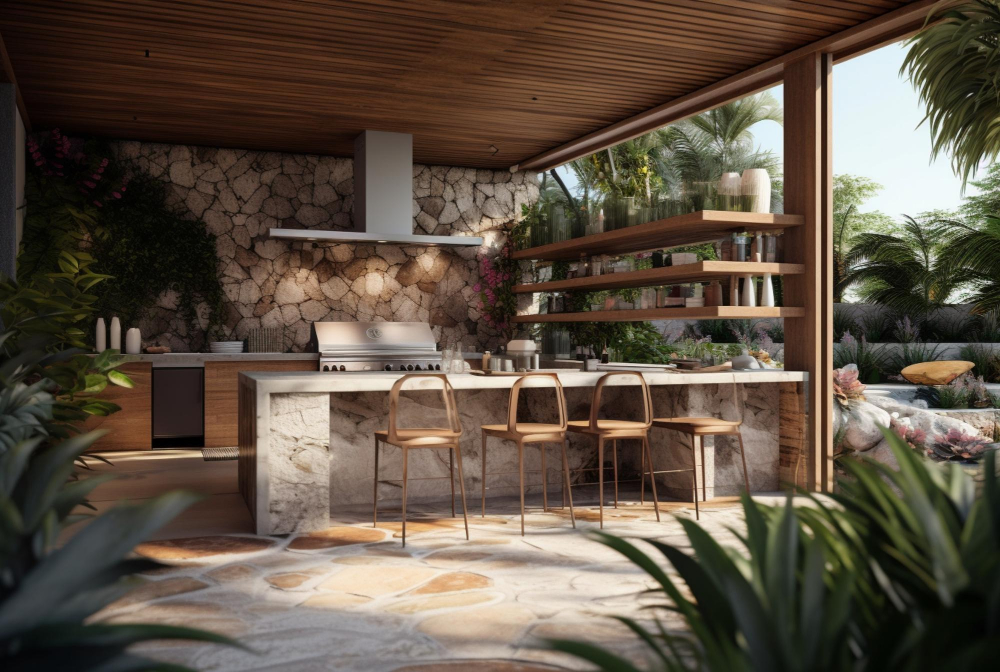
This is where vent hoods come into play. Understanding their importance in outdoor kitchens can make a significant difference in your overall cooking experience.
Vent hoods serve as a crucial component of any kitchen setup by effectively removing smoke, steam, heat, and airborne particles that are produced during cooking. In an indoor kitchen setting, these pollutants are typically directed outside through ductwork or filtered through charcoal or carbon filters before being recirculated back into the room.
In an outdoor kitchen environment where there may not be walls or ceilings to contain these emissions naturally like indoors do; having a vent hood becomes even more critical. Without proper ventilation measures in place outdoors when grilling up steaks or frying up some delicious tempura vegetables on your built-in cooktops could result in unpleasant experiences such as excessive smoke accumulation around you and guests’ eyes watering from all those fumes.
Moreover – without adequate ventilation – grease particles released during high-heat grilling can settle on nearby surfaces leading to unsightly stains that require extensive cleaning efforts later on down the line if left unaddressed initially!
The Benefits of Having a Vent Hood in Your Outdoor Kitchen
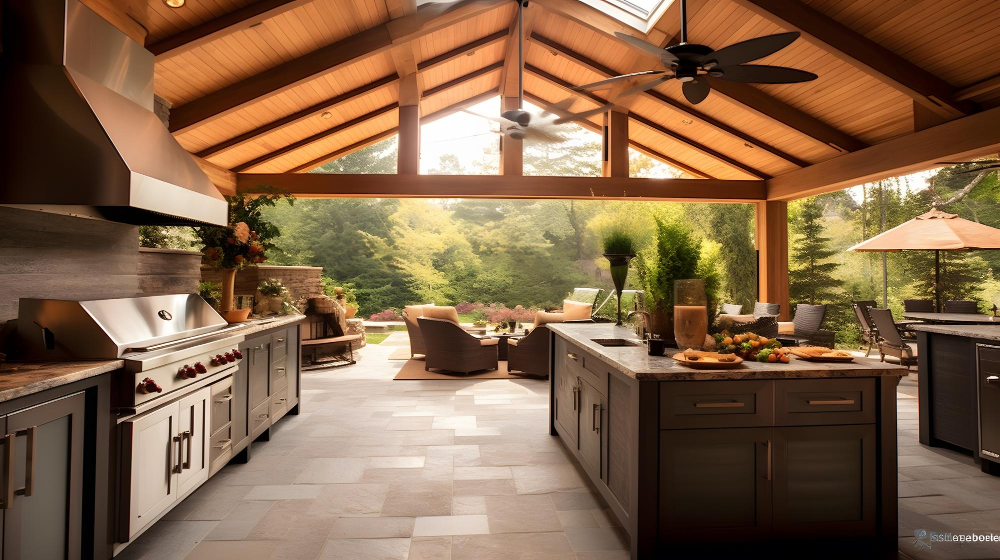
Not only does it help to improve air quality and remove smoke, but it also plays a crucial role in maintaining the longevity of your outdoor kitchen appliances.
When you’re grilling up a storm or experimenting with different culinary creations, smoke and odors are bound to be produced. Without proper ventilation, these elements can quickly accumulate and create an uncomfortable environment for both you and your guests.
A vent hood effectively captures the smoke, grease particles, and other airborne pollutants generated during cooking, preventing them from lingering around the cooking area.
In addition to improving air quality by removing unwanted odors and fumes from the space, a vent hood also helps prevent grease buildup on surfaces surrounding your outdoor kitchen. Grease accumulation not only poses fire hazards but can also lead to unsightly stains on walls or nearby furniture.
Furthermore, having a properly functioning vent hood ensures that heat is efficiently extracted from under the grill or cooktop surface. This prevents excessive heat buildup in enclosed spaces such as covered patios or pergolas where many outdoor kitchens are located.
By dissipating excess heat through its exhaust system effectively, a vent hood helps maintain comfortable temperatures while you cook outdoors even during hot summer days.
Lastly yet importantly, a well-designed ventilation system can contribute to preserving the lifespan of your expensive outdoor appliances. By reducing exposure to excessive heat, smoke residue, and moisture caused by condensation,.
Vent hoods help prevent premature wear-and-tear.
And potential damage.
To sensitive components.
Of grills,.
Ovens,.
Or other equipment.
In an open-air setting.
With all these benefits combined,.
It’s clear that investing.
In a high-quality.
Your outdoor.
Kitchen is well worth considering.
Not only will it ensure.
That you have clean,.
Fresh air while enjoying.
.
Your outdoor cooking adventures,.
But it will also protect.
Your investment in.
Outdoor appliances and enhance.
Importance of Ventilation in Outdoor Kitchens

Without proper ventilation, smoke, odors, and heat can quickly accumulate in the space, making it unpleasant for both the cook and any guests.
When you’re grilling up your favorite steaks or experimenting with new recipes outdoors, having good airflow is essential to maintain air quality and prevent excessive heat buildup. A well-designed ventilation system will effectively remove smoke from grills or other cooking appliances while also dissipating excess heat.
Not only does proper ventilation enhance comfort levels by reducing smoke and odors but it also helps to minimize potential health hazards associated with inhaling airborne particles produced during cooking processes. This is especially important if you have allergies or respiratory sensitivities among your family members or guests.
Adequate airflow prevents grease buildup on surfaces surrounding your outdoor kitchen setup. Grease accumulation not only creates an unsightly mess but can also pose fire risks if left unattended.
By incorporating a vent hood into your outdoor kitchen design plan right from the start ensures that these concerns are addressed effectively so that you can fully enjoy every moment spent preparing meals outside without worrying about discomfort or safety issues caused by poor air circulation.
Do You Really Need a Vent Hood in Your Outdoor Kitchen?

After all, cooking outdoors already provides some natural ventilation, right? While it’s true that the open air can help dissipate smoke and odors to some extent, having a dedicated vent hood in your outdoor kitchen brings numerous benefits that shouldn’t be overlooked.
One of the primary reasons why a vent hood is essential for an outdoor kitchen is its ability to effectively remove smoke and grease from the cooking area. Grilling or frying foods can produce significant amounts of smoke and airborne particles that can quickly accumulate in an enclosed space.
Without proper ventilation, this buildup not only affects air quality but also leaves behind stubborn residue on surfaces surrounding your grill or cooktop.
Having a vent hood helps maintain comfort while you’re preparing meals outside. It helps prevent excessive heat buildup by drawing hot air away from the cooking area and expelling it outside.
This ensures that both you and your guests stay cool even during intense grilling sessions on scorching summer days.
Furthermore, installing a vent hood promotes safety by reducing fire hazards associated with indoor/outdoor kitchens without proper ventilation systems in place. Grease-laden vapors are highly flammable; therefore removing them promptly minimizes the risk of accidental fires erupting during food preparation.
Lastly but certainly not least important – investing in a high-quality vent hood adds value to your overall outdoor living space design as well as enhances its functionality. Not only does it provide practical benefits like improved air quality and temperature control but also contributes aesthetically by adding an attractive focal point above your grill or cooktop setup.
While there might be debate about whether certain features are necessary for an ideal outdoor kitchen experience – such as fancy appliances or elaborate seating areas – when it comes to ensuring optimal performance along with safety considerations within this unique culinary environment – having a reliable ventilating system like a vent hood is undoubtedly a must-have.
Different Types of Vent Hoods for Outdoor Kitchens

Let’s take a closer look at some of the options you can consider.
1. Wall-Mounted Vent Hoods: These are the most common type of vent hoods used in outdoor kitchens.
As the name suggests, they are mounted on an exterior wall above your cooking area. Wall-mounted vent hoods effectively capture smoke, grease, and odors from your grill or cooktop and expel them outside through ductwork.
2. Island Vent Hoods: If your outdoor kitchen is designed with a central island or cooking station away from any walls, an island vent hood is a great choice.
These stylish units hang from the ceiling directly above your cooking surface and provide efficient ventilation without obstructing sightlines across your outdoor space.
- Downdraft Ventilation Systems: For those who prefer a sleeker look without visible overhead ventilation, downdraft systems offer an alternative solution for removing smoke and fumes in open-air settings like patios or decks with no walls nearby.
- Outdoor Range Hoods : Specifically designed for heavy-duty grilling setups such as built-in gas grills or large smokers , these range hooads have higher CFM (cubic feet per minute) ratings compared to standard models . They ensure effective removal of heat ,smoke,and grease generated by intense high-heat cooking methods .
5. Ductless Vent Hods: If installing ductwork is not feasible in your outdoor kitchen setup, you can opt for ductless vent hods .These units use filters to trap airborne particles before recirculating clean air back into the space. While they may not be as effective as their ducted counterparts at removing all odors ,smoke,and grease completely.
Each type has its own advantages depending on factors such as layout constraints, personal preferences regarding aesthetics versus functionality, and the intensity of your cooking activities. Consider consulting with a professional to determine which type of vent hood will best suit your outdoor kitchen setup.
Comparing Ducted and Ductless Options for Outdoor Kitchen Vent Hoods

Both have their advantages and considerations, so let’s take a closer look at each.
Ducted vent hoods are the more traditional choice and work by extracting smoke, grease, and odors from your cooking area through a series of ducts that lead outside. These hoods are highly effective in removing pollutants from the air while maintaining proper ventilation.
By expelling the exhaust outdoors, they help keep your outdoor space clean and free of lingering smells.
On the other hand, if installing ductwork is not feasible or desirable for your outdoor kitchen setup, you may opt for a ductless vent hood instead. Ductless options use filters to capture airborne particles before recirculating clean air back into the space.
While they may not be as efficient as their ducted counterparts in terms of odor removal or smoke extraction since they don’t remove contaminants directly from outside; they can still provide adequate ventilation when properly maintained.
Choosing between these two options depends on various factors such as budget constraints, available infrastructure (like access to an exterior wall), local building codes/regulations regarding ventilation systems installation requirements among others – all worth considering before making this decision.
Selecting the Right Vent Hood for Your Outdoor Kitchen
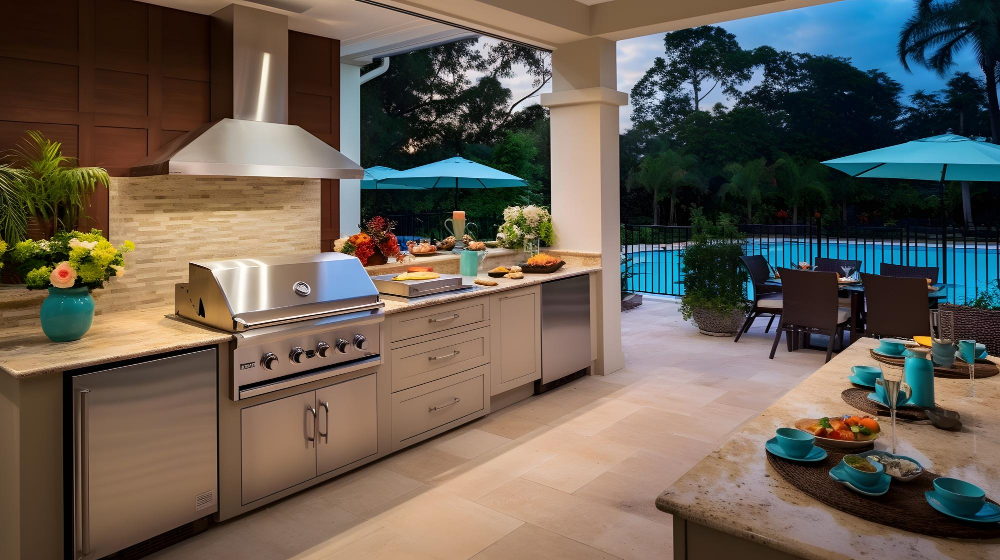
The first is the size of your cooking area. Vent hoods come in various sizes, so you’ll want to choose one that adequately covers the space where you’ll be doing most of your cooking.
Next, think about the type of cooking you plan on doing in your outdoor kitchen. If you’re primarily grilling or using a smoker, a simple range hood may suffice.
However, if you have more elaborate appliances like pizza ovens or deep fryers that produce higher levels of smoke and grease particles, then opting for a more powerful and specialized vent hood would be wise.
Consider whether ducted or ductless ventilation is suitable for your setup. Ducted vent hoods require proper installation with an exhaust system leading outside to effectively remove smoke and odors from your outdoor kitchen area.
On the other hand, ductless options use filters to trap grease particles and recirculate clean air back into space.
Another important consideration when selecting an outdoor vent hood is its material construction. Since it will be exposed to various weather conditions such as rain and sunlight throughout its lifespan outdoors; choosing materials like stainless steel can ensure durability while maintaining aesthetic appeal.
Lastly but equally crucial is budgeting appropriately for this investment in order not only get value-for-money but also avoid compromising on quality features necessary for efficient ventilation within an open-air environment like an outdoor kitchen setting.
Considering Vent Hood Size and Material for Outdoor Kitchens
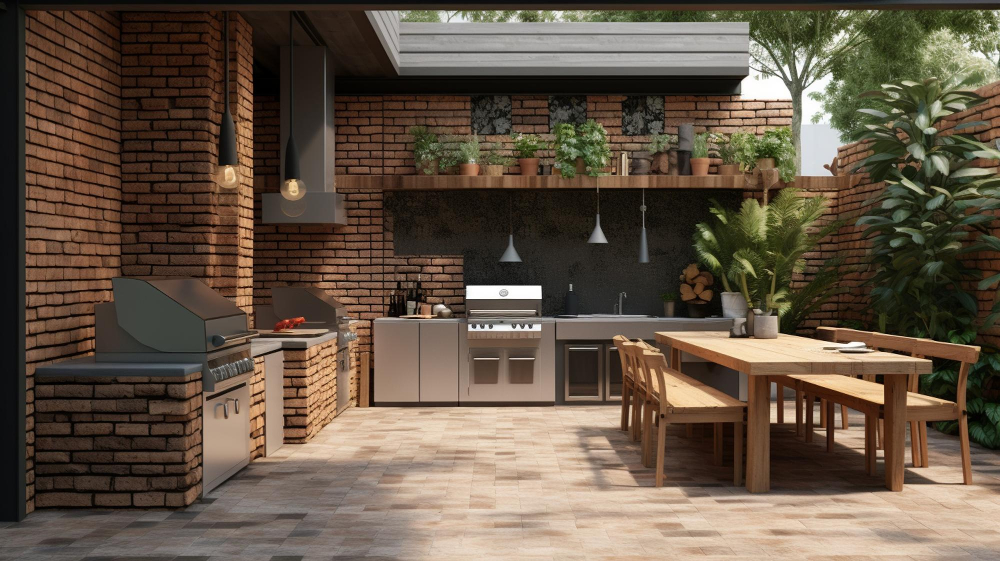
The size of the vent hood should be proportional to the cooking equipment you have in your outdoor kitchen. A larger grill or multiple cooking appliances may require a larger vent hood with higher airflow capacity.
The material of the vent hood plays an important role in its durability and performance. Stainless steel is a popular choice for outdoor kitchens due to its resistance against corrosion and ability to withstand harsh weather conditions.
It is also easy to clean and maintain, making it ideal for outdoor environments.
However, there are other materials available as well, such as copper or powder-coated finishes that can add aesthetic appeal while still providing functionality.
When selecting both size and material for your vent hood, it’s essential not only to consider their practical aspects but also how they will complement the overall design of your outdoor kitchen space. Finding a balance between functionality and aesthetics will ensure that you have an efficient ventilation system that enhances both your cooking experience and visual appeal.
Positioning Vent Hoods for Maximum Efficiency
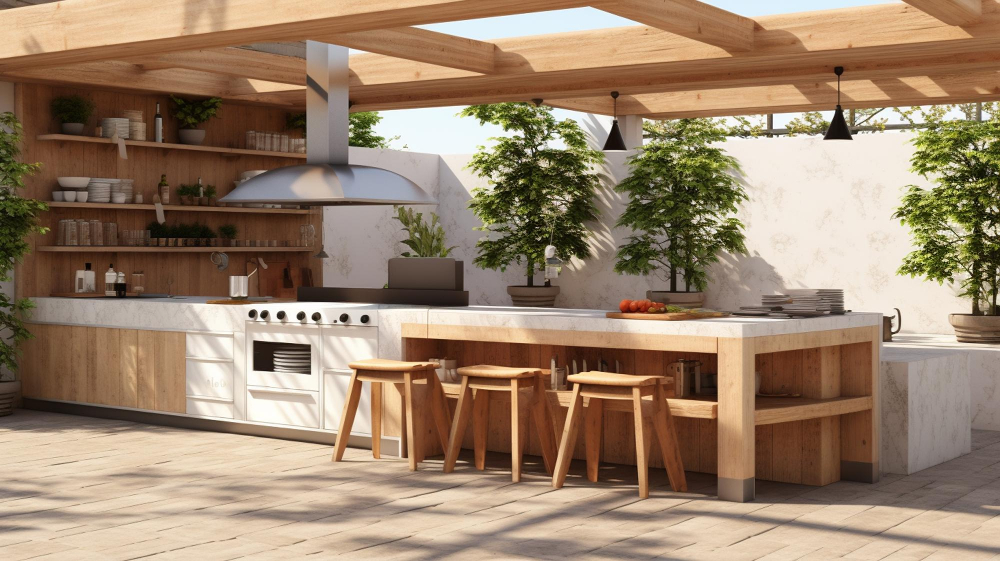
The placement of your vent hood plays a significant role in ensuring effective ventilation and smoke extraction while you cook up a storm.
When determining where to position your vent hood, consider its proximity to the cooking area. Ideally, it should be installed directly above or behind the grill or cooking surface.
This allows for efficient capture and removal of smoke, grease particles, and odors right at their source.
Take into account any prevailing wind patterns in your outdoor space. Positioning the vent hood against prevailing winds can help enhance its performance by aiding in proper airflow direction and preventing backdrafts.
Another factor to consider is clearance space around the vent hood. Ensure there is enough room between overhead structures such as pergolas or roofs so that air can flow freely through the exhaust system without obstruction.
Furthermore, pay attention to nearby walls or cabinets when deciding on placement. It’s essential to provide sufficient distance between these surfaces and your vent hood so that they don’t interfere with proper airflow circulation.
Lastly but importantly – safety first! Make sure there are no flammable materials near where you plan on installing your outdoor kitchen’s ventilation system; this will minimize fire hazards during cooking sessions while keeping everyone safe from potential accidents caused by heat exposure or sparks flying out from grills!
Optimal Mounting Height for Outdoor Kitchen Vent Hoods

The placement of your vent hood plays a significant role in its effectiveness and overall functionality.
Ideally, the vent hood should be mounted at a height that allows it to capture smoke, grease, and odors effectively. A common recommendation is to position the bottom of the hood between 24-30 inches above your cooking surface.
This range ensures that the ventilation system can efficiently remove any airborne particles generated during cooking.
Mounting too low can result in inadequate capture and ventilation capabilities as smoke may escape before being properly extracted. On the other hand, mounting too high might lead to reduced efficiency as air circulation becomes less effective.
Consider factors such as personal comfort while standing or sitting near your outdoor kitchen when determining an appropriate mounting height for your vent hood. Take into account any specific manufacturer recommendations provided with your chosen model for optimal performance.
Installation Process of Vent Hoods

While it may seem like a daunting task, installing a vent hood can be relatively straightforward with proper planning and execution.
Firstly, it’s important to determine the ideal location for your vent hood. Consider factors such as proximity to cooking appliances and ease of access for maintenance.
Most commonly, vent hoods are installed directly above the cooking area or grill to effectively capture smoke, grease, and odors.
Before beginning any installation work, ensure that you have all necessary tools and materials on hand. This typically includes screws or brackets for mounting purposes along with appropriate ventilation ducts if required.
Next comes preparing the space for installation. If your outdoor kitchen already has an existing structure or canopy in place where you plan on installing the vent hood, make sure it is sturdy enough to support its weight securely.
Once everything is set up correctly according to manufacturer guidelines (which should always be followed), proceed with attaching brackets or screws firmly into place using appropriate hardware provided by manufacturers specifically designed for outdoor use.
After securing these components properly onto their designated spots within reach from where they’ll connect later during final assembly stages – usually near electrical outlets nearby – carefully attach ventilation ductwork if applicable based upon whether opting either ducted system requiring external exhaust connection via wall/roof penetration OR choosing non-ducted recirculating option utilizing charcoal filters inside unit itself instead of expelling air outside altogether through vents leading outdoors).
Lastly but not least importantly: double-check all connections before powering up equipment! Ensure there are no loose wires nor leaks present anywhere throughout entire setup ensuring optimal performance while minimizing potential hazards associated when operating gas-powered grills alongside electrically powered fans/motors found within most modern-day range hoods available today!
Key Considerations for Vent Hood Installation in Outdoor Kitchens

These factors will ensure that your vent hood functions effectively and efficiently, providing you with a comfortable cooking environment.
Firstly, the location of the vent hood is crucial. You’ll want to position it directly above your cooking area so that it can effectively capture and remove smoke, grease, and odors.
Consider the layout of your outdoor kitchen and choose a spot where the vent hood will have maximum coverage.
Next, think about ventilation requirements. Outdoor kitchens often have different airflow patterns compared to indoor spaces due to open sides or partially covered areas.
It’s important to assess how air circulates within your outdoor kitchen space before deciding on the type of ventilation system you need for optimal performance.
Consider whether you prefer a ducted or ductless option for your vent hood installation. Ducted hoods require proper routing of exhaust pipes through walls or ceilings while ductless hoods use filters to recirculate air back into space after purification.
Each option has its pros and cons depending on factors such as convenience, maintenance needs,and local building codes.
Another vital consideration is sizing – selecting an appropriately sized vent hood based on both aesthetics and functionality is essential for efficient operation.The size should be proportional not onlytothe dimensionsofyouroutdoorkitchenbutalsothecookingappliancesyouintendtouse.Consultingwithaprofessionalcanhelpyoudeterminethecorrectsizetomeetyourspecificneedsandensureproperventilationcoverageforallcookingareaswithintheoutdoorkitchenlayout. Lastly,don’t forget about power supply requirements during installation.Planningforadequateelectricalconnectionsisimportanttomake surethatyourventhoodoperatesreliablyandefficiently.Checkthepowerrequirementsforthemodelyouchooseandmakearrangementsforanappropriatesourceofelectricitynearby.
By considering these key factors during the installation process, you can ensure that your vent hood is positioned correctly, properly ventilated, and appropriately sized for your outdoor kitchen.
Cost Estimation of Outdoor Kitchen Vent Hoods

And while the cost of an outdoor kitchen can vary greatly depending on factors such as size, materials, and appliances, it’s important to factor in the cost of a vent hood as well.
The price range for outdoor kitchen vent hoods can vary significantly based on several factors. The type of vent hood you choose – whether it’s ducted or ductless – will have an impact on the overall cost.
Ducted vent hoods tend to be more expensive due to their installation requirements and additional components needed for proper ventilation.
The size and material of the vent hood will also affect its price. Larger hoods made from high-quality stainless steel are generally more expensive than smaller ones or those made from other materials.
On average, you can expect to spend anywhere between $500 and $2,000 for a quality outdoor kitchen vent hood. However, keep in mind that this is just an estimate and prices may vary depending on your specific needs and preferences.
It’s worth noting that investing in a good quality vent hood is essential not only for ensuring proper ventilation but also for protecting your investment in your outdoor kitchen appliances by preventing grease buildup or smoke damage over time.
Before making any purchasing decisions regarding your outdoor kitchen setup including choosing a specific model or brand of ventilator make sure you do thorough research comparing different options available within various budgets so that you find one which suits both functionally aesthetically without breaking bank!
Troubleshooting Common Vent Hood Issues
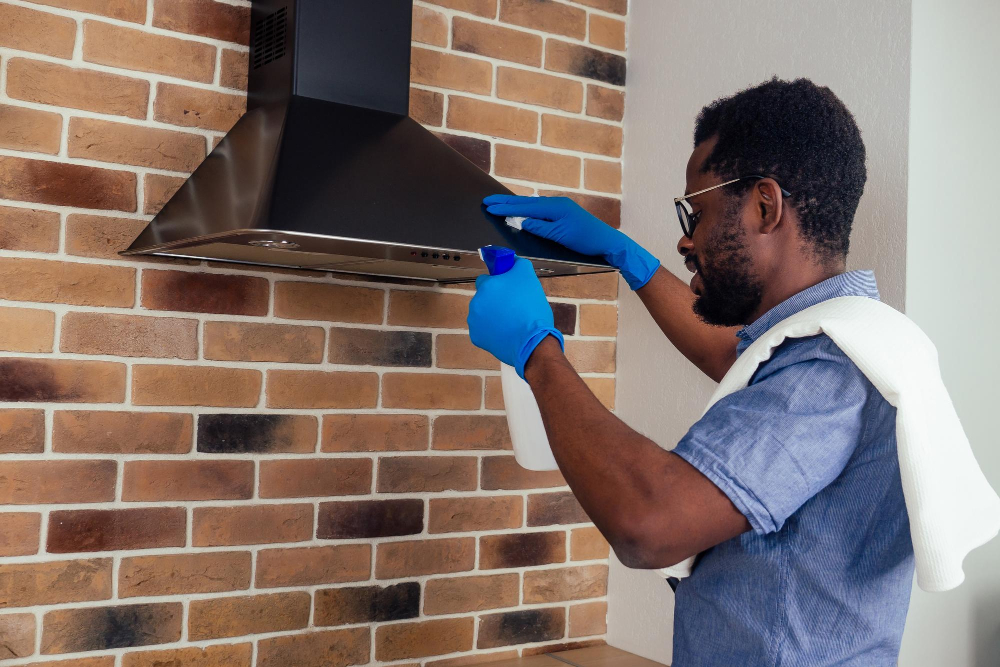
While vent hoods are designed to effectively remove smoke, odors, and grease from the air while you cook, they can sometimes encounter problems that hinder their performance. In this section, we will discuss some common vent hood issues and provide troubleshooting tips to help you resolve them quickly.
One common issue with outdoor kitchen vent hoods is poor airflow or weak suction power. If you notice that your hood isn’t pulling in smoke or odors as efficiently as before, check if the filters are clogged with grease or debris.
Regularly cleaning or replacing these filters can significantly improve airflow.
Another problem could be excessive noise coming from the fan motor of your vent hood. This could indicate a loose fan blade or worn-out bearings within the motor itself.
In such cases, it is best to contact a professional technician who specializes in repairing ventilation systems.
Sometimes vents might emit unpleasant smells instead of removing them entirely due to improper installation or lack of regular maintenance on ductwork and exhaust pipes leading outside your home’s exterior walls. Ensure there are no blockages obstructing proper air circulation through these channels by inspecting them regularly for debris buildup.
If you experience water dripping from your vent hood during rain showers despite having adequate protection against weather elements like rain caps installed on top of chimneys/vents – this may suggest an issue with flashing around those areas where moisture seeps into gaps between roofing materials causing leaks inside kitchens below roofs’ surfaces; consult professionals specializing in waterproofing solutions promptly!
Maintenance and Care for Vent Hoods
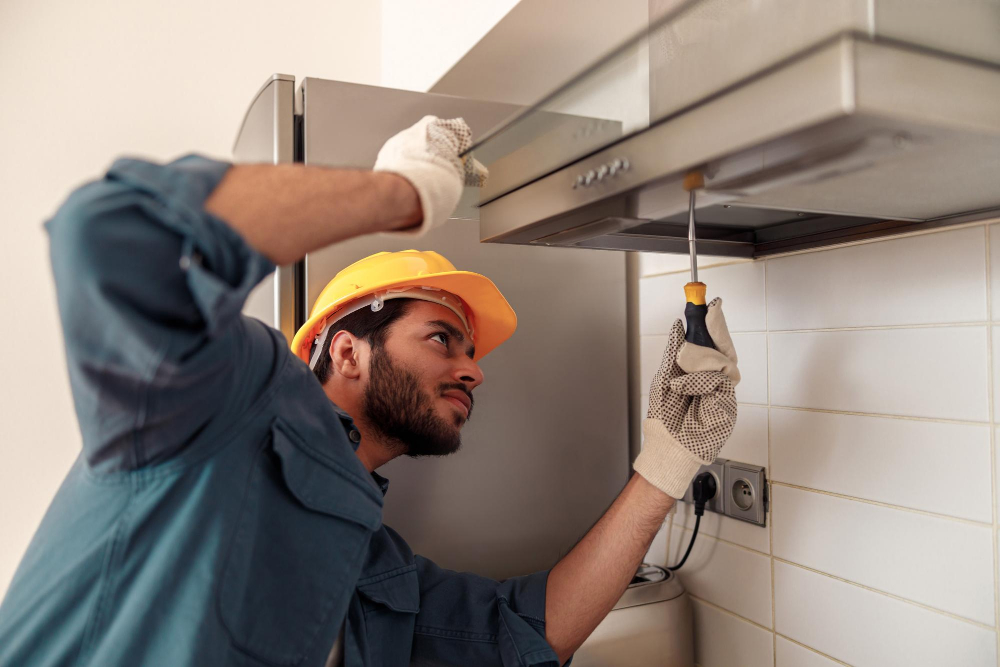
Regular maintenance will not only ensure the longevity of your vent hood but also keep it functioning at its best, allowing you to enjoy cooking without any issues.
To start with, one of the most crucial aspects of maintaining a vent hood is keeping it clean. Over time, grease and debris can accumulate on the surfaces and filters of the hood.
It’s recommended to clean these components regularly using mild dish soap or specialized cleaning solutions designed for vent hoods. Be sure to follow manufacturer instructions when cleaning specific parts such as stainless steel surfaces or mesh filters.
In addition to regular cleaning, inspecting and replacing air filters is essential for optimal performance. Filters trap grease particles from escaping into your outdoor space while allowing proper airflow through the system.
Depending on usage frequency, check if they need replacement every few months or as advised by manufacturers.
Another aspect often overlooked is checking for any loose connections or damaged parts within the ventilation system itself. Inspect ductwork periodically for leaks that may hinder proper airflow efficiency; repair them promptly if found.
Lastly, consider scheduling professional maintenance checks at least once a year by qualified technicians who specialize in outdoor kitchen ventilation systems specifically. They can thoroughly inspect all components including fans motors electrical connections etc., ensuring everything operates smoothly while addressing any potential issues before they become major problems.
Safety Considerations With Vent Hoods

While vent hoods are primarily designed to remove smoke, odors, and grease from the air, they also play a crucial role in ensuring the safety of your outdoor kitchen. Here are some important safety considerations to keep in mind when it comes to vent hoods:
1. Fire Prevention: One of the main functions of a vent hood is to eliminate grease particles that can accumulate during cooking.
Grease buildup not only affects the efficiency of your ventilation system but can also pose a fire hazard if left unchecked. Regular cleaning and maintenance of your vent hood will help prevent any potential fire risks.
2. Proper Installation: It’s essential that you have your vent hood professionally installed according to manufacturer guidelines and local building codes for safe operation.
Improper installation may lead to inadequate ventilation or even structural damage due to excessive heat exposure.
3.Carbon Monoxide Detection: Outdoor kitchens often utilize gas-powered appliances such as grills or cooktops which produce carbon monoxide (CO) emissions during combustion processes.If you’re using gas-powered equipment in conjunction with an enclosed space like an outdoor kitchen island,it’s crucially importantto install carbon monoxide detectors near these areas for early detection and preventionof CO poisoning incidents.
4.Electrical Safety Measures: Vent hoods require electrical connections for proper functioning.Make sure all electrical componentsare properly groundedand protected from moisture exposure.Always follow recommended procedures while handling electricity,and consult professionals if needed,to ensure safe installationand usageofyourventhoodsystem.
5.ProximitytoFlammableMaterials:A well-designedoutdoorkitchenwill take into accountthe placementof flammable materials,such as wooden structuresor combustible surfaces.Avoid installingyourventhoodtoo close totthese materialsasit could increase theriskoffire hazards.Ensureadequate clearancebetweenflammable itemsandtheventing systemfor optimal safety.
By considering these safety aspects, you can enjoy your outdoor cooking experience with peace of mind. Remember to consult professionals for proper installation and maintenance of your vent hood, as they will have the expertise to ensure that all necessary safety measures are in place.
Impact of Weather On Outdoor Vent Hoods
As we all know, outdoor cooking means being exposed to the elements, and this can have a significant effect on the performance and durability of your vent hood.
Rain showers are a common occurrence in many regions, and without proper protection or design considerations for your vent hood, water can seep into sensitive components such as motors or electrical connections. This could lead to malfunctions or even permanent damage if not addressed promptly.
Similarly, strong winds can create havoc by blowing smoke back into your cooking area instead of directing it out through the vent hood. This defeats its purpose entirely and may result in an unpleasant experience for you and your guests.
Extreme temperatures also play a role in how well an outdoor kitchen’s ventilation system functions. High heat from grilling combined with scorching summer temperatures might put additional strain on certain materials used in constructing the vent hoods.
It’s essential to choose materials that are resistant to heat distortion so that they maintain their structural integrity over time.
On colder days when you still want to enjoy some al fresco cooking sessions but face chilly gusts of wind blowing across your patio space – having a properly functioning vent hood becomes even more critical! It helps prevent smoke from lingering around while keeping you warm by efficiently removing any unwanted odors or fumes generated during food preparation.
To ensure optimal performance regardless of weather conditions, consider investing in high-quality stainless steel construction for both durability against rusting caused by rain exposure as well as resistance against extreme temperature fluctuations commonly experienced outdoors throughout different seasons. By taking these factors into account when selecting an appropriate model suitable for use outside year-round – rest assured knowing that no matter what Mother Nature throws at you; she won’t dampen spirits nor compromise safety levels associated with using gas-powered appliances near combustible surfaces like wood decks/patios!
Building Regulations and Permissions for Vent Hoods

While these requirements can vary depending on your location, understanding the rules will ensure that you comply with local codes and avoid any potential issues down the line.
Before embarking on your outdoor kitchen project, it is advisable to check with your local authorities or consult a professional who is familiar with building regulations in your area. They will be able to provide guidance on specific requirements for vent hoods in outdoor kitchens.
Building regulations often cover aspects such as proper ventilation, fire safety measures, electrical wiring standards, and structural considerations. These guidelines are put in place for both safety reasons and maintaining aesthetic harmony within neighborhoods.
In some cases, obtaining permits may also be necessary before installing a vent hood in an outdoor kitchen. Permits typically involve submitting plans or specifications of the proposed installation along with payment of applicable fees.
The purpose behind permits is to ensure that installations meet certain standards set by regulatory bodies.
By adhering to these building regulations and obtaining any required permissions beforehand ensures not only compliance but also peace of mind knowing that you have created a safe environment for cooking outdoors while avoiding potential legal complications later on.
FAQ
Does an outdoor kitchen need a hood?
Yes, an outdoor kitchen requires a vent hood to remove grease, smoke, and strong cooking odors, and to prevent grease and oils from staining cabinets, walls, and countertops.
Do I need a hood for my outdoor grill?
Yes, a hood is necessary for your outdoor grill if it is set up underneath a lanai, porch, or other structure with a solid ceiling to make your cooking safer and more enjoyable.
Do kitchen exhaust fans need to be vented outside?
Yes, most kitchen exhaust fans need to be vented outside primarily due to health reasons as they are designed to move smokey, greasy polluted air outside instead of recirculating it inside.
How do you vent an outdoor kitchen?
An outdoor kitchen can be vented by placing a vent panel every 6-feet in the kitchen space, potentially placing a set of vents on each side or one side with another on the backside of the structure, with an emphasis that having too many vents is not detrimental.
What are the benefits of having a vent hood in an outdoor kitchen?
Vent hoods in an outdoor kitchen can reduce smoke, improve air quality, and help control heat.
Can you operate an outdoor kitchen without proper venting system?
No, you cannot operate an outdoor kitchen without a proper venting system.
What is the best way to install a vent hood in an outdoor kitchen?
The best way to install a vent hood in an outdoor kitchen is by securing it in the desired location, making necessary electrical connections and testing for functionality, as per the specific instructions provided by the manufacturer.




